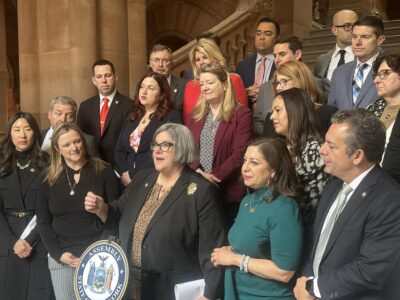Fiscal firestorms fuel discontent at universities

OBSERVER file photo Academic program cuts have been met with protest at the State University of New York at Fredonia as well as other higher learning institutions.
Throughout his nearly five-year tenure as State University of New York at Fredonia president, Stephen Kolison has — at least publicly — come across as soft spoken. During press conferences and while leading meetings, he has rarely appeared to be too optimistic or overly disappointed.
That was not the case on April 7 during a University Senate meeting.
Before a debate regarding a potential no-confidence resolution, Kolison uncharacteristically went on the defensive in criticizing a report by two consultants with SUNY ties that was critical of his leadership and what was considered a “soured” campus environment. From his perspective, the findings were “heavy on opinions, misinformation, disinformation and innuendos.”
Faculty members shared the report with the OBSERVER shortly before the meeting earlier this month. The Senate is composed of faculty representatives from every academic department and area, professional staff and management representatives from each of the university divisions on campus, and undergraduate and graduate student representatives.
“The Senate has a job to do, I have a job to do, and we’ll see what happens,” Kolison said at the meeting. “My plan is to work hard every day so this school winds up in a good place.”
From the beginning, Kolison has been in a rugged spot. His arrival in August 2020 came as campuses nationwide were debating how to handle the return of students for the first time since the COVID pandemic had begun five months earlier. Within a month, the village’s most infamous boil-water water crisis lasted for 20 days that frustrated an already beleaguered enrollment that was facing restrictions and uncertainties related to the virus. At that point, enrollment was 4,400. Today, it is closer to 3,200 — a 27% decline.
Over the next two years, deficits at the institution kept climbing as enrollment numbers were spiraling. At one point in recent years, it was reportedly as high as $17 million.
There would be no infusion of funds from Albany to fix the fiscal woes. Instead, a mandate for rightsizing was sought by the state. It began in December 2023 with Kolison’s announcement that eliminated 13 degree programs that had minimal enrollment.
Despite protests from staff and students that came shortly after the announcement, SUNY officials noted progress at the location in February. Enrollment was reported to have increased 7.2% in the fall and the deficit had been reduced to $4.1 million.
Those glowing reviews have not been shared by campus faculty and staff, which led to the talk of the no-confidence vote. Some of the dissent could be justified in the belief that the administration at the university of today is much larger than it was decades ago. That seems to be a trend in higher education and mirrors what is happening in the state’s public school system, especially at the local districts.
All this being said, what message would a no-confidence vote really send? It is not like college administrators are coming forward by the handful.
Besides, if Kolison’s plan to reduce expenses is not the path the University Senate believes the campus should take, what are the alternatives? Revenues are in decline and New York state rarely makes SUNY funding increases a priority.
Buffalo State’s fiscal situation is not all that different from what is taking place in the county. Its leader, Interim President Dr. Bonita Durand, returned to her previous role to announce the discontinuation of 37 academic programs last May while more recently offering retirement incentives to reduce its deficit. “I am confident that our Buffalo State University community can both ensure our long-term financial sustainability while continuing to do what we do best: delivering a high-quality educational experience for our students,” Durand said last spring.
Results there have been mixed. Its deficit has been reduced by 25% to around $12 million while there are concerns about low graduation rates.
Across the nation, prominent campuses are making similar choices. Kent State, the University of Dayton and Wagner College — all in Ohio — announced reductions while West Virginia University in September 2023 was likely the earliest — and most notorious — in attempting to right its $45 million shortfall by cutting some 300 positions.
Back at Fredonia, the no-confidence vote did not make it to the floor at the meeting this month. There is one more University Senate meeting in May before the spring semester comes to a close.
Kolison inherited years of indecision by a previous administration once he took the helm. Slow progress may look good in the eyes of Albany, but it will not take him off the hot seat with the local employees.
John D’Agostino is editor of The Post-Journal, OBSERVER and Times Observer in Warren, Pa. Send comments to jdagostino@observertoday.com or call 716-487-1111, ext. 253.






